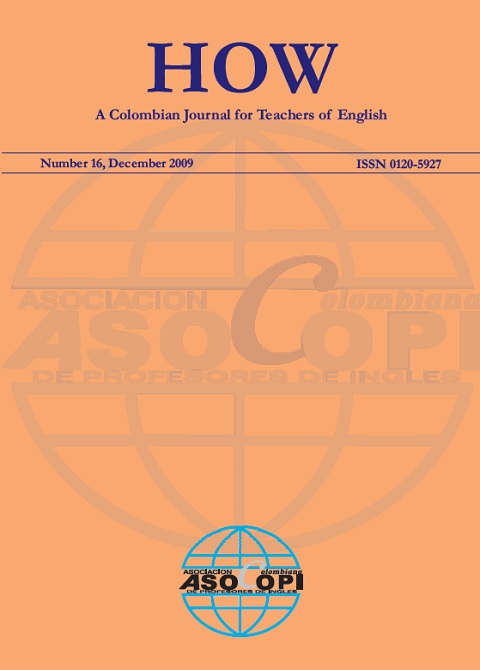Más allá de la lectura en el salón de clase: los efectos de la lectura extensiva en la USTA, Tunja
Contenido principal del artículo
Resumen
Detalles del artículo
Los contenidos de la revista HOW se publican bajo la licencia Creative Commons Atribución-NoComercial-SinDerivar 4.0 Internacional. Usted es libre para copiar y redistribuir el material en cualquier medio o formato siempre y cuando usted otorgue el crédito de manera apropiada. Usted no puede hacer uso del material con fines comerciales. Si usted mezcla, transforma o crea nuevo material a partir de esta obra, usted no podrá distribuir el material modificado. Más información: http://creativecommons.org/licenses/by-nc-nd/4.0/deed.es.
Se solicitará a los autores cuyos artículos se aceptan para publicación en HOW que firmen una cesión de derechos no exclusiva con el fin de permitir a ASOCOPI reproducir el texto completo en el internet o en cualquier otro medio disponible. Los autores conservan los derechos sobre sus manuscritos con las siguientes restricciones: el derecho de primera publicación es otorgado a ASOCOPI; los autores pueden establecer acuerdos no exclusivos con terceros siempre y cuando la publicación original en la revista HOW sea reconocida adecuadamente.
Citas
Bandler, R. & Grindler, J. (1979). Frogs into princes: Neuro-linguistic programming. Boulder, CO: Real People Press.
Bell, T. (2007). Intensive versus extensive reading: A study of the use of graded readers as supplementary input material to traditional “Intensive” reading techniques. Unpublished MA TEFL Dissertations. University of Reading.
Cohen, D. & Crabtree, B. (2006). Qualitative Research Guidelines Project. Retrieved from: http://www.qualres.org/HomeSemi-3629.html
Davis, C. (1995). Extensive Reading: An expensive extravagance? English Language Teaching Journal, 49(4), pp. 329-336.
Day, R.R. & Bamford, J. (1998). Extensive reading in the second language classroom. New York: Cambridge University Press.
Dubravcic, J. (1996). Telling the truth about extensive reading. The Language Teacher, 20(12), p. 52.
Ellis, R. (1987). Second language acquisition in context. New York: Prentice Hall.
Elley, W. B., & Mangubhai, F. (1983). The effect of reading on second language learning. Reading Research Quarterly, 19(1), pp. 53-67.
Green, C. (2005). Integrating extensive reading in the task-based curriculum. ELT Journal, 59(4), pp. 306-311.
Hill, J. & Lewis, M. (Eds.) (1997). Dictionary of selected collocations. England: Language Teaching Publications.
Merriam, S. (1988). Case study research in education: A qualitative approach. San Francisco, CA: Jossey–Bass.
Nagy, W.E. & Herman, P. (1987). Breadth and depth of vocabulary knowledge: Implications for acquisition and instruction. In Mckeown, M. & Curtis, M. (Eds), The nature of vocabulary acquisition. (pp. 19-35) Hillsdale, NJ: Lawrence Erlbaum Associates.
Nunan, D. (1992). Research methods in language learning. Cambridge: Cambridge University Press.
Robb, T. N. & Susser, B. (1989a). Extensive reading vs. skills building in an EFL context. Reading in a Foreign Language, 5(2), pp. 239-251.
Robb, T.N. & Susser, B. (1989b). Developing extensive reading. JALT Newsletter, 6(1), pp. 1-5.
Thompson, C. (1983) Intensive and extensive reading - A summary, for practicing teachers, of material presented by Damien Tunnacliffe at JALT '83. The Language Teacher, 8(4), 21-22.
Tsang, Wai-King. (1996). Comparing the effects of reading and writing on writing performance. Applied Linguistics, 17(2), pp. 210-223.

